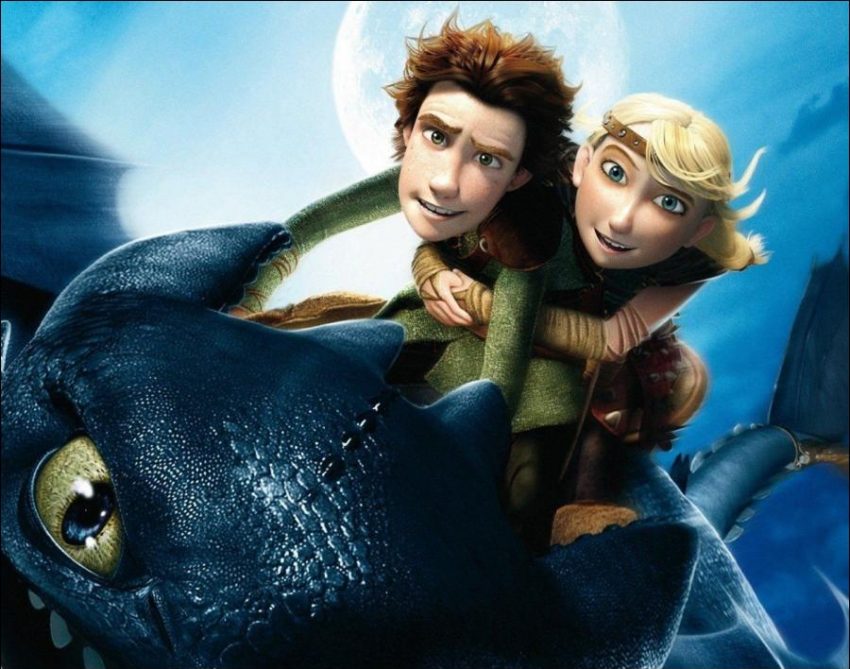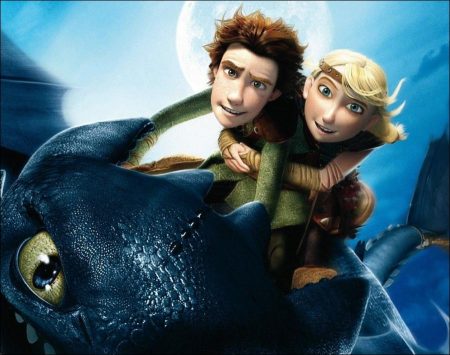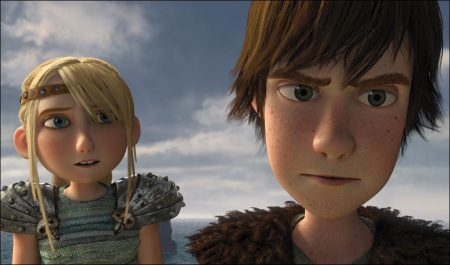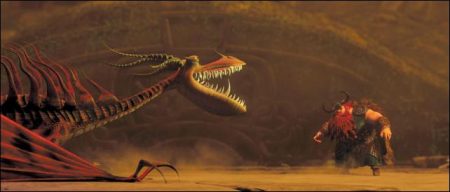Taglines: One adventure will change two worlds.
Hiccup is a Viking teenager who doesn’t exactly fit in with his tribe’s longstanding tradition of heroic dragon slayers. Hiccup’s world is turned upside down when he encounters a dragon that challenges he and his fellow Vikings to see the world from an entirely different point of view.
The story centers around a Viking teenager named Hiccup (Jay Baruchel), who lives on the Island of Berk, where fighting dragons is a way of life. The teen’s rather progressive views and offbeat sense of humor don’t sit too well with his tribe or its chief…who just happens to be Hiccup’s father, Stoick the Vast (Gerard Butler).
When Hiccup is included in Dragon Training with the other Viking teens—Astrid (America Ferrera), Snotlout (Jonah Hill), Fishlegs (Christopher Mintzplasse), and twins Ruffnut (Kristen Wiig) and Tuffnut (T.J. Miller)—he sees his chance to prove he has what it takes to be a fighter. But when he encounters (and ultimately befriends) an injured dragon, his world is flipped upside down, and what started out as Hiccup’s one shot to prove himself turns into an opportunity to set a new course for the future of the entire tribe.
It was nearly six years ago when the book series of British author Cressida Cowell came to the attention of creative executives at DreamWorks Animation. With an established reputation for taking small but well-respected titles and spinning them into box office success, it didn’t take more than a Norse minute for them to see the cinematic potential in the exploits of a scrawny kid named Hiccup trying to find his niche in the brawny world of Vikings. “If you’re writing about Vikings and Dragons it has got to be something that is going to be on a grand scale,” says Cowell. “I was incredibly excited when DreamWorks expressed interest in the books, as I knew they could do the movie on a scale that I could barely even imagine!”
Coming off of her success of the DreamWorks suburban adventure comedy “Over the Hedge,” it also didn’t take long for producer Bonnie Arnold to become interested in the newly acquired property. She kept her eye on the project as it bubbled its way through the development process, and when DreamWorks Animation co-president of production Bill Damaschke asked her what she wanted to work on next, she chose “How to Train Your Dragon.”
For Arnold, one of the biggest challenges as a producer was taking an established world like the one created in Cowell’s books and adapting it into a full-length feature film. “We wanted to make the film a big event, a real action-adventure with great characters that would be appealing to a broad audience,” explains Arnold. “In all our other movies, the main characters are adults or animals, but in this film, we have a teenager as our hero and that is a new direction for the studio. Hiccup’s personality and his interactions with the dragons and the different personalities of the Vikings are the basis for the humor in the story, versus humor that is more satire or topical. It’s got adventure and humor and heart, the elements were all there, but we just needed a strong writing/directing team to help shape it.”
To helm the project, the studio turned to Oscar®-nominated writer/director Chris Sanders and writer/director Dean DeBlois. For Sanders, the attraction to Hiccup’s tale was immediate: “I think the story inside this story is one of emotional depth, which I thought was exciting, but what piqued my interest were the flying sequences,” says Sanders. “For a very long time, I have wanted to do a film that somehow involved creatures, people or superheroes flying, so when I read an early version of this story, I thought, ‘Oh, my gosh! We can take that to places that you’ve never been before!’”
“Chris called me up on a weekend right after Jeffrey Katzenberg had talked to him,” adds writer/director Dean DeBlois, “and he mentioned that ‘How to Train Your Dragon’ was something that was really in my wheelhouse, specifically, a teenaged protagonist in a larger-than-life fantasy action-adventure. And that’s really something that I am drawn to—those are the stories that I write. I immediately was engaged and I read the book. I could see a lot of potential for what could be, and working with Chris again just sounded like an exciting thing.”
While the book picks up at a point where dragons have become integrated into the Vikings’ societal structure, the filmmakers saw that taking the timeline back a few years would prove to be key. Explains Arnold, “In terms of storytelling, I think our breakthrough was crafting an origin story—how Hiccup and his relationship with a dragon named Toothless really changed his world. It was this story we wanted to tell, about how he started the relationship between the Vikings and the dragons that led to the adventures in the books, the ones that we hear about, and know and love.”
Cowell’s books were loosely based on the author’s childhood experiences spent on a remote, uninhabited island off of the west coast of Scotland. Without roads, houses or electricity, it was the ideal setting for a young Cowell’s imagination to run wild, the backdrop that would later provide a foundation for the world of Vikings and dragons in her stories. It wasn’t much of a stretch to see herself in the scrappy Viking-in-training named Hiccup, with a chief named Stoick for a father. Yet even though Hiccup is as far from the standard Viking physique as one can get, he still yearns and tries to become a fighter in a society of warriors.
“Vikings are tough, with a code and a creed,” explains Sanders. “Fighting is second nature to them. If you’re a Viking, you just don’t back down from a fight— you’re physically strong, you’re brave, you don’t flinch. The thing about Hiccup that we love is that he wants to be a Viking. It’s not like he woke up one day and said, ‘I wish I weren’t one of these guys.’ On the contrary, he desperately wants to be one of them.”
That perspective helped the filmmakers shape the motivation and personality of Hiccup into that of a teenager realizing his own potential. “He doesn’t quite understand everything that is going on around him, but one thing is clear—his perspective and abilities are different,” continues Sanders. “His dad doesn’t get it, the village doesn’t get it. But we do, and that’s what we love about the character.”
Head of story Alessandro Carloni offers, “There were many inspiring qualities in the book that we wanted to incorporate into the film. There was definitely a lot of charm in how the author described the everyday life of Vikings. We wanted to kick it all up a notch, age up the protagonist and set it firmly in the action-adventure genre. We wanted to keep the charm of the language, but show it in another way. How do Vikings live, travel, hunt? That’s where we began.”
“And that comes from DreamWorks Animation’s own chief,” says Chris Sanders. “If you’re doing something halfway, he’ll catch it. He reminds you that while you’re solving story problems, you’re also making a movie. He always challenges you to be bold bold with what you’re doing. To never settle. To go all the way.”
But at the core of everything, as always, is the story, and in that the studio found its champions in the pairing of Sanders and DeBlois. As producer Bonnie Arnold observes, “Chris and Dean, at their core, are great storytellers. You can have all the great animation, music, sound effects, you name it, but it has to be supporting a great story. As directors and writers they had in their head a way to tell this story, a very specific adaptation of a beloved book. They are particularly good at communicating that to everyone on the project. It’s my job, and the crew’s job, to realize that vision on the screen. They’re great at inspiring everyone, which, in turn, challenges all of us to bring back something better.”
Sanders and Deblois met working on “Mulan,” and had their first collaboration writing and directing together on “Lilo & Stitch,” nominated for the Best Animated Feature of 2002 by the Academy of Motion Picture Arts and Sciences. The two found that working together improved their craft. Says DeBlois, “We seemed to connect on the same sorts of ideas—we can arrive at the same end result, but we come at it from different perspectives. I think that I’m able to take on his ideas and add to them without derailing them, and I think he does the same for me. So as we write or direct together, it turns out to be a really beneficial arrangement—there’s a sense of creative simpatico. We complement each other.”
“We have a good working relationship. For us, the trick is to be hard on the story and test it for weakness, but not go too far and end up with a movie that’s lost its delicate parts. You want to craft a tale that makes sense, but still retains its surprises and magic. The only way to do that is to trust each other, to really believe in each other’s instincts. Dean and I have the same overall sensibilities, and tend to strike the same tone with our storytelling.
That said, we usually come at things from different directions, so we are very liable to write scenes differently than the other one would, but usually arrive in the right place. We outline the story together but then divvy up the scenes and dive into them individually. It’s how we cover the most ground. Then we read each other’s pages. I’m always surprised at the angle Dean takes, but I always like where he ends up, or where he’s heading. I make sure my notes concentrate on making his scenes work, and don’t try to change them into scenes I would have written. He does the same for me. Our movies are a true collaboration.”
In turn, the pair found their champion in Arnold. “Bonnie’s great—you can tell she’s done this many times before,” says Sanders. “She protects the film, and is totally onboard for what you as a director and a writer are trying to accomplish. She gives us a safe space in which to create. She fights for us as well, and the mostly wordless scenes of Hiccup and Toothless beginning their friendship, they wouldn’t be in the film, if we didn’t feel like this was a safe environment.”
DeBlois seconds, “Bonnie really excels at taking any number of chaotic situations that arise during production and getting right to the heart of what’s important. And that’s the best thing—as a producer, that’s what you really need in the filmmaking mix. So, I trust her, and know that she always has the film’s best intentions at heart.”
How toTrain Your Dragon 3D (2010)
Directed by: Chris Sanders
Starring: Gerard Butler, America Ferrera, Jonah Hill, Jay Baruchel, Christopher Mintz-Plasse, Ashley Jensen, Kristen Wiig, Craig Ferguson, Robin Atkin Downes, David Tennant, Philip McGrade
Screenplay by: Dean DeBlois
Production Design by: Kathy Altieri
Film Editing by: Maryann Brandon, Darren T. Holmes
Art Direction by: Pierre-Olivier Vincent
Music by: John Powell
MPAA Rating: PG for sequences of intense action and some scary images, and brief mild language.
Oistributed by: DreamWorks Pictures
Release Date: March 26, 2010








